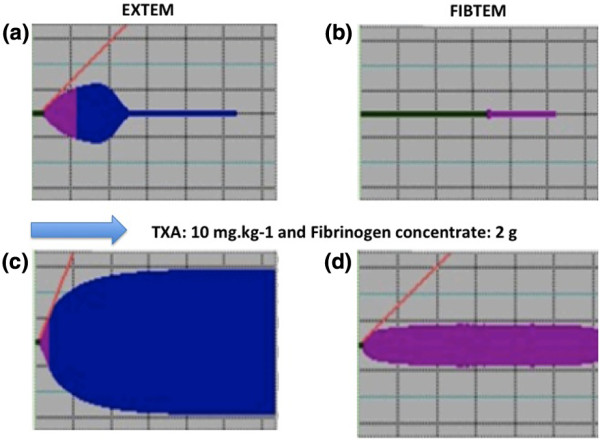We read with interest the paper published by Repressé and colleagues [1]. Coagulation management is a challenge during extracorporeal membrane oxygenation (ECMO) due to complex hemostatic and inflammatory responses associated with the underlying conditions that include infection, sepsis, surgery, and/or traumatic injury [2]. Repressé and colleagues present the first algorithm-based approach to bleeding in ECMO patients. However, additional perspectives are important to consider.
First, activated partial thromboplastin time or antiactivated factor × monitoring are routinely used to monitor heparin therapy in ECMO patients, despite intraindividual and inter-individual variability [3]. Rotational thromboelastometry (ROTEM®; TEM® International GmbH, Munich, Germany) is also increasingly used in the ICU to rapidly assess the coagulation status, including clotting factors, fibrinogen levels, and whole blood clotting [4]. Moreover, this test also facilitates fibrinolytic pathway evaluation, which cannot be easily explored by routine laboratory tests. We believe ROTEM® could be used to design an algorithm-based approach to bleeding in ECMO patients and follow fibrinogen consumption associated with hyperfibrinolysis, an important cause of bleeding. For this reason, anti-fibrinolytic agents should be considered in the multimodal approach (Figure 1), an important point the authors omitted in their algorithm.
Figure 1.

Hyperfibrinolysis diagnosed in a bleeding extracorporeal membrane oxygenation patient. (a) Baseline EXTEM, (b) baseline FIBTEM, (c) EXTEM and (d) FIBTEM thromboelastometry tests after the administration of tranexamic acid (TXA; 10 mg/kg) and fibrinogen concentrates (2 g).
Second, adverse events including 32% venous thrombosis and a 2.5% incidence of fatal pulmonary embolism have already been reported in ECMO patients [5]. In another series, Combes and colleagues reported a 10% incidence of femoral vein and 7% incidence vena cava thrombosis [6]. Recombinant activated factor VII is associated with thromboembolic events [7] and should be used with caution until additional data help us evaluate the benefit-to-risk administration in bleeding ECMO patients.
Abbreviations
ECMO: extracorporeal membrane oxygenation; ROTEM: rotational thromboelastometry.
Competing interests
The authors declare that they have no competing interests.
See related research by Repressé et al., http://ccforum.com/content/17/2/R55
Contributor Information
David Faraoni, Email: davidfaraoni@me.com.
Jerrold H Levy, Email: lerrold.levy@duke.edu.
References
- Repressé X, Au SM, Brechot N, Trouillet J, Leprince P, Chastre J, Combes A, Luyt CE. Recombinant factor VIIa for uncontrollable bleeding in patients with extracorporeal membrane oxygenation: report on 15 cases and literature review. Crit Care. 2013;17:R55. doi: 10.1186/cc12581. [DOI] [PMC free article] [PubMed] [Google Scholar]
- Peek GJ, Firmin RK. The inflammatory and coagulative response to prolonged extracorporeal membrane oxygenation. ASAIO J. 1999;45:250–263. doi: 10.1097/00002480-199907000-00003. [DOI] [PubMed] [Google Scholar]
- Dempfle CE, Elmas E, Link A, Suvajac N, Liebe V, Janes J, Borggrefe M. Endogenous plasma activated protein C levels and the effect of enoxaparin and drotrecogin alfa (activated) on markers of coagulation activation and fibrinolysis in pulmonary embolism. Crit Care. 2011;15:R23. doi: 10.1186/cc9968. [DOI] [PMC free article] [PubMed] [Google Scholar]
- Bischof D. Thrombelastography in the surgical patient. Minerva Anestesiol. 2010;76:131–137. [PubMed] [Google Scholar]
- Rastan AJ, Lachmann N, Walther T, Doll N, Gradistanac T, Gommert JF, Lehmann S, Wittekind C, Mohr FW. Autopsy findings in patients on postcardiotomy extracorporeal membrane oxygenation (ECMO) Int J Artif Organs. 2006;29:1121–1131. doi: 10.1177/039139880602901205. [DOI] [PubMed] [Google Scholar]
- Combes A, Leprince P, Luyt CE, Bonnet N, Trouillet JL, Leger P, Pavie A, Chastre J. Outcomes and long-term quality-of-life of patients supported by extracorporeal membrane oxygenation for refractory cardiogenic shock. Crit Care Med. 2008;36:1404–1411. doi: 10.1097/CCM.0b013e31816f7cf7. [DOI] [PubMed] [Google Scholar]
- Levy JH, Faraoni D, Sniecinski RM. Perioperative coagulation management in the intensive care unit. Curr Opin Anaesthesiol. 2013;26:65–70. doi: 10.1097/ACO.0b013e32835b82df. [DOI] [PubMed] [Google Scholar]


